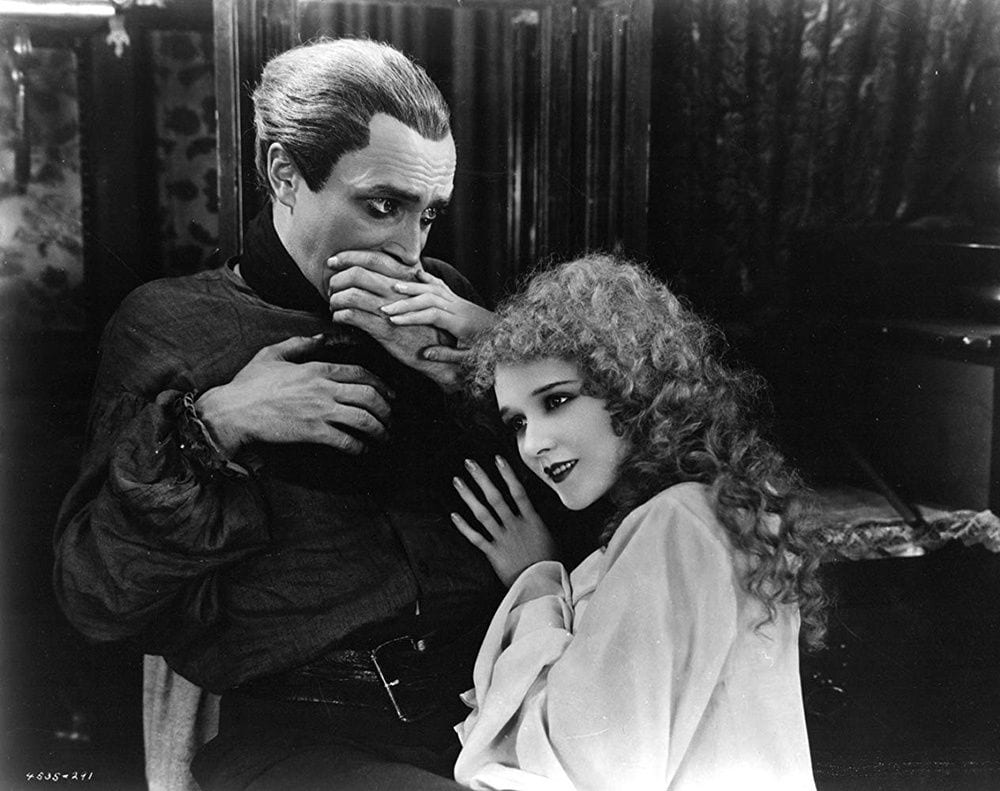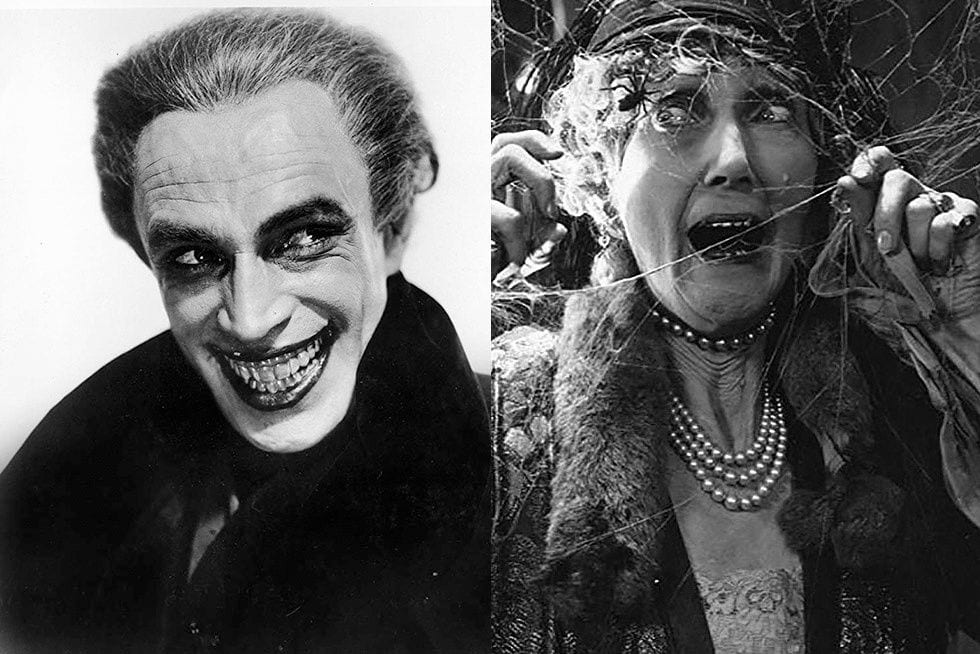

Universal Pictures in Hollywood imported Paul Leni, a German Expressionist director notable for Waxworks (1924), to their dream factory. There he made four fascinating films before his untimely death by a tooth infection in 1929 at age 44. This loss to film history may be compared to that of his countryman, F.W. Murnau, also imported to Hollywood, who died in a 1931 car accident at 42. Leni isn’t recalled as often as Murnau, but perhaps that can be partly remedied by Universal’s 4K restorations of two of Leni’s films, now available on Blu-ray/DVD combos from Flicker Alley: The Man Who Laughs (1928) and The LastWarning (1929).
Leni’s first two Universal productions where thrillers released in 1927. The Cat and the Canary remains one of the most visually dynamic and witty of the “old dark house” films infesting theaters at the time. Its two main stars are Leni’s camera, which continually places the viewer in the middle of the action, and Laura La Plante, one of the studio’s most delightful and natural silent personalities.
Leni followed this great success with the screen’s very first Charlie Chan feature, The Chinese Parrot (1927), starring Japanese actor Sojin Kamiyama. There had been a 1926 Chan serial, The House Without a Key, starring Japanese-American George Kuwa, who also had a role in The Chinese Parrot. The reason nobody remembers that Asian actors were the first to play the Hawaiian detective is because these films are lost, so we’re unable to judge them today and hardly know about them. Contemporary articles indicate that Chan’s role was miminized in both productions. We’d sure like to see how Leni’s camera and gift for visual design handled this assignment.
Then came The Man Who Laughs, based on Victor Hugo’s 1869 novel. This project follows Universal’s trend of big-budget historical-literary items with grotesque and thrilling elements — namely the two Lon Chaney blockbusters, The Hunchback of Notre Dame (1923, directed by Wallace Worsley) and The Phantom of the Opera (1925, directed by Rupert Julian). Today they’re often classed as horror films, although that wasn’t a genre category at the time.
The first of those Chaney items was also based on a Hugo novel and the second co-starred Mary Philbin, so The Man Who Laughs was very much hoping for the best of both worlds by casting Philbin in another Hugo tale. The grotesque lead was taken over by another veteran of German Expressionism, Conrad Veidt of the long fingers, pointy chin, and big forehead. Tailor-made for macabre and strange characters, he broke through as Cesare the somnambulist in Robert Wiene’s The Cabinet of Dr. Caligari (1920) and had been among the stars of Waxworks. As a spectacular star of silent cinema, he’s not exactly known for subtle realism; later, he was typecast as Nazi officers, most famously in Michael Curtiz’s Casablanca (1942).

While those Chaney hits boast some sense of flamboyance, most of what we’d call their style consists of pointing the camera at Chaney and staying out of the way. They’re very effective, especially the brilliant unmasking of the Phantom, but Leni’s approach of moving the camera, seeking evocative angles and compositions, and casting expressionist shadows belongs to another class. He works here with Gilbert Warrenton, who’d shot The Cat and the Canary. We shiver to consider what they might have done with the chandelier scene in The Phantom of the Opera.
The Man Who Laughs remains a grotesque, oppressive, uncanny near-tragedy about acting and masks and, above all, cruelty. The story begins during the reign of James II (Samuel de Grasse), presented as a sickly scrawny figure in his nightshirt, awakened by his equally cruel jester (Brandon Hurst) for the purpose of consigning an upstart lord (Veidt in a dual role) to the iron maiden. First, they inform him that his young son Gwynplaine (child actor Julius Molnar, Jr.) has had a grin carved permanently into his face by some kind of Gypsies called “Comprachicos” (invented by Hugo).
Now orphaned, the boy wanders through the snow (of course) and discovers a baby girl wrapped in the arms of her dead mother under a row of gibbets as decaying corpses swing from them. In other words, horror is piled upon horror before the children are taken in by a traveling “philosopher” and actor called Ursus (Cesare Gravina). Fast forward many years, and the adult Gwynplaine (Veidt) is now famous all over England as “the Laughing Man”, a full-time clown who, as a fellow performer tells him, is lucky because he doesn’t have to remove his makeup.
Philbin plays the grown girl, Dea, blind but radiant (always standing in a heavenly spotlight) and therefore neither repelled nor provoked to laughter by her beloved Gwynplaine. Of course, our hero is rarely ever happy, much less laughing, over his carved mouth. Tears often quiver at his ducts amid the pancake makeup, for one effective aspect of Veidt’s performance is that he also keeps his eyes wide open. His grimace is both true and false, thus paradoxical, while we’ve been told that the jester’s smiles are always false, as are the painted smiles of Gwynplaine’s fellow clowns.

A large part of the story takes place at the court of Queen Anne (Josephine Crowell), who’s even less sympathetic than the depiction by Olivia Colman in last year’s The Favourite. That film makes an interesting comparison, as it retroactively throws light on the Queen’s vindictive schemes against the most prominent member of her court and presumably once a favorite, Duchess Josiana, who gets a peek-a-boo bathing scene. She’s played by Olga Baclanova, whose immortality rests on her role as the evil bride in Tod Browning’s Freaks (1932), one of the most grotesque films of all time and one whose gruesome finalé may owe something to this movie’s “Comprachicos”.
Josiana is depicted as a sexually free woman who doesn’t care who’s offended by her behavior, whether the Queen or her foppish betrothed (Stuart Holmes). Anne intends to humble her by restoring the position of the long-lost Gwynplaine and having the Duchess marry him, but Josiana’s ahead of the Queen, for she’s already begun vamping the Laughing Man for her own amusement even before this scheme was underway. That’s how perverse she is, the film implies.
Josiana is depicted as “acting” when she shows up in court, and she also masquerades as a peasant when attending the fair. At Gwynplaine’s performance, she sees his naked “laughing” face while coyly putting up a domino mask. In short, everything about court life and its denizens is presented as a lie and an act, every move calculated by everyone, all pointedly in elaborate wigs and makeup, and this state of affairs is compared with the tatty play-acting of Ursus’ troupe, where Gwynplaine wears a permanent mask that’s his actual face.
A class element is introduced in that the peasants, who at once mock Gwynplaine and “love” him, or at least pack the theaters for him, also defend him against the royal guards who chase after him while he’s trying to get back to the fainting Dea. She’s not very useful to the plot, but her lover gets to buckle some swash on a high parapet, and there’s also a heroic dog who comes to the rescue, thus proving that beasts and blind girls are the most loyal and reliable figures when you’ve got a face like a death’s-head.
Other silents at this time traded on the concept of the secretly sad clown, such as the same year’s Chaney drama Laugh, Clown, Laugh, directed by Herbert Brenon, but this one is hands down the most elegant and bizarre. Among those frightened and impressed by Veidt’s hideous, fascinating makeup were the artists who created the Joker in the Batman comics. Another impressionable viewer might have been young Ray Russell, who grew up to write the story and film of William Castle’s Mr. Sardonicus (1961), whose protagonist is deformed in a similarly hideous manner.
The credits for The Man Who Laughs show several people who would go on to important horror films. Makekup artist Jack Pierce, central to this film’s effect, later created Boris Karloff’s makeup for James Whale‘s Frankenstein (1931), while art director Charles D. Hall made his mark on several of Universal’s biggest horrors of the same period, including Frankenstein and Tod Browning’s Dracula (1931). Editor Edward Cahn became a prolific B director of items such as It! The Terror from Beyond Space (1958) and Invisible Invaders (1959), which respectively foreshadow Ridley Scott’s Alien (1979) and George Romero’s Night of the Living Dead (1968).
Production supervisor Paul Kohner would produce the Spanish-language version of Dracula that was shot simultaneously with the Bela Lugosi version. According to the bonus essay, this Jewish executive was engaged to Philbin but her parents put the kibosh on the idea due to different religions. That’s interesting and fortuitous, because he’d go on to marry Mexican actress Lupita Tovar, whom he imported to star in the Spanish Dracula. Although presumably Catholic, she doesn’t seem to have had the same objections (or perhaps no parents), and their daughter Susan Kohner played the “black” daughter who passes for white in Douglas Sirk’s Imitation of Life (1959). And now you know the rest of the story.
Kino issued a DVD of The Man Who Laughs back in 2003, then reissued it as part of a 2007 box set; both are out of print and expensive. That doesn’t matter, because this new 4K digital restoration is gorgeous, deriving from a 35mm fine grain print struck by Universal in 1954 from the nitrate negative. Aside from a gallery of promotional items, the only significant extra is an essay on the film. Viewers have two soundtrack choices: a music-and-effects track from 1928 or a new score from Berklee School of Music. Kevin Brownlow has written an informative history for the booklet.

Leni’s final film, The Last Warning brings back Laura La Plante of The Cat and the Canary for another poke at the “old dark house” genre, this time in parody of The Phantom of the Opera. As was common in the transitional year of 1929, the film was released in both silent and partial-sound versions, though only the silent (and reportedly better) incarnation survives.
As with The Cat and the Canary, The Last Warning is a witty, visually dynamic movie in which the hectic goings-on are continually japed by comic-relief characters and droll effects. The cameraman this time around is Hal Mohr, and Charles D. Hall still provides the art direction. He didn’t have to create the majestic theatre, since standing sets from The Phantom of the Opera were recycled.
PopMatters has reviewed this film here, when a print was released on DVD by Grapevine Video, so we won’t rehash the plot or its exuberant effects. For this Blu-ray, Universal combined a 35mm nitrate dupe negative from France with a 16mm print at UCLA, so this would seem a complete edition. While most of it looks very good, they haven’t blown the same amount of cash to fix up scratches and debris (perhaps from the 16mm print) as on The Man Who Laughs. The results still look excellent and this movie fully deserves the Blu-ray treatment. I’m holding on to both editions because the Grapevine print is tinted and some of its visual details come through more clearly, like the glimpse of a semi-nude portrait of Josephine Baker during the opening montage. Some movies are so good, you can’t have too many versions floating around.
Extras include promotional slideshows and a brief essay on the film by author John Soister, who provides more information in the booklet. The new score by Arthur Barrow at times seems to mimic the era’s music-and-effects tracks by incorporating whistles and other onscreen devices effectively.
Let us hope that more of Leni’s surviving films find their way to Blu-ray in new digital restorations, as we hope also that these releases do something to restore the luster to his reputation. As Soister reports, he was at one point mooted to direct Dracula with Veidt as his star, but multiple events — not least Leni’s death — derailed those plans. Imagining what his camera style could have brought to that project can make us swoon. Leni deserves to be recalled as an important director of thrillers and as an artist who understood how to bring the audience into his visual world.
- Slapstick, Thrills, Spooks and Camera Tricks in the 9.5mm Format ...
- The Man Who Laughs (1928) - PopMatters
- Little Orphant Annie, Restored Silent Film (review) - PopMatters
- Marc Ribot: Silent Movies - PopMatters
- Pioneers: First Women Filmmakers (film feature) - PopMatters
- The Alice Howell Collection (film review) - PopMatters
- San Francisco Silent Film Festival 2018: A Transformative Cinematic ...
- Harold Lloyd Is a Real Hickory in Silent Film The Kid Brother ...
- Silent Film Film History in Shadow and Light - PopMatters
- An Engaging Guide to the 24th San Francisco Silent Film Festival
- Sherlock Holmes' Silent Film(s) 'Der Hund von Baskerville ...
- Lois Weber to Louise Brooks: Eight Silent Film Sensations ...
- Clowns Are Up to a Different Kind of Funny Business, These Days ...
- Silent Film 'The Man Who Laughs' Is Serious Cinema - PopMatters

